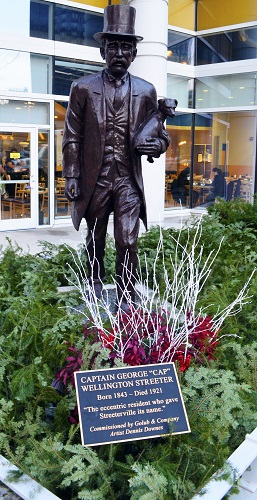This week in 1886, Captain George Wellington Streeter crashed his steamboat into a sandbar in Lake Michigan, beginning one of the strangest, most colorful sagas in the history of Illinois that led to the founding of one of Chicago’s most famous neighborhoods.
The Reutan was a 35-ton steamboat piloted by boatman, Civil War veteran and circus owner “Cap” Streeter, who was returning to Chicago from Milwaukee. Streeter’s boat ran aground on Lake Michigan near the present-day intersection of Fairbanks Court and Superior Avenue in Chicago on July 11, 1886. At that time, the city had not yet expanded to the east. According to Cap and his wife Maria’s official statements, the Reutan was badly damaged by a storm when the wind and waves carried her to rest about 450 feet from shore.
The Streeters remained in the Reutan and invited local contractors to dump debris from the Chicago Fire, which had ravaged the city 15 years earlier, near the sand bar, creating a landfill which they claimed as their land. They named their 186 acres the District of Lake Michigan, which they claimed was a federal district independent of the state of Illinois. It was not until three years later that authorities would attempt to physically remove the Streeters from their land. With loaded rifles, George and Maria drove five constables out of the District of Lake Michigan.
At the end of the 1800s, Chicago experienced a building boom and Streeter’s land became increasingly valuable, which led to a feud with Mayor John Wentworth, who alleged that the captain was merely an opportunist attempting to make a land grab. Streeter’s disagreement with the mayor fueled his popularity and cemented his place as a folk hero and urban legend as he endured years of legal battles, standoffs with law enforcement and even imprisonment. Even though his claims to the land were found to be without merit in 1918, Streeter continued to defend his domain until he died of pneumonia in 1921 at the age of 84.
Following Streeter’s death, developers began building at a furious pace throughout the area once known as the District of Lake Michigan. That area of Chicago has since come to be known as Streeterville, after its eccentric founder. The thriving neighborhood built over debris from the Chicago fire has since become iconic.
Streeterville contains Chicago landmarks such as the Magnificent Mile, Water Tower Place and the John Hancock Building as well as universities, hospitals and cathedrals. It is a thriving neighborhood that draws people of all walks of life to explore, live, work, shop and eat every day. Were it not for Cap Streeter’s colorful antics, Illinois would be without one of its great cultural and economic sites.




